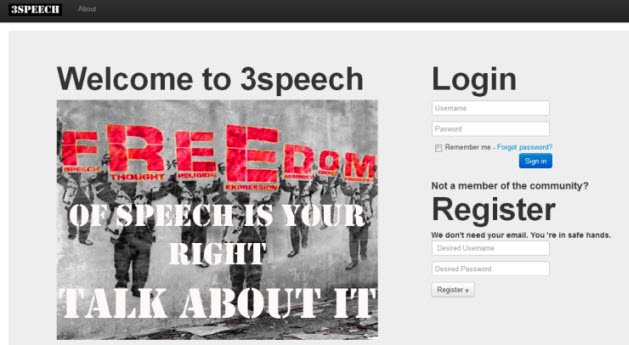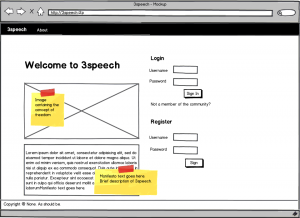Archive for category Front-end Design
3speech on the World Wide Web
Posted by epan in Front-end Design, Other on May 10, 2012
Since 3speech can only be accessed through the i2p network, we decided to raise awareness of our platform by using a domain in the World Wide Web. The figure below shows a screenshot of the created webpage.
The webpage will also contain details instructions on how to install i2p and reach the community of 3speech.
User Interface Screenshot
Posted by epan in Front-end Design on May 10, 2012
Based on the research on User Interface design and the choice of a navigation scheme, we started building a demo user interface.
First of all, we created the login page of 3speech. This is what we came up with:
The page will contain the following manifest:
From now on, it can never be the same as before…because the place we are from does not exist anymore.
The Web is changing, and not for the better. Online freedom of speech is under attack by authorities, corporations and governments. Lobbyists are twisting anti-piracy laws to hide their true intentions and to further their own agendas. Censorship is their weapon of choice and they are trying to utilize it to its fullest extent. They are trying to limit the free flow of information at the cost of your fundamental right to free speech. This cannot be accepted. This should not be accepted.
What we are seeing is only the beginning and things will only get worse. The only solution is to raise awareness and promote open conversations about the issues that matter. 3SPEECH is not the answer, but where the answers can be created.
It is the place where ideas and discussions can take place, allowing its users to remain unaccountable, untraceable and untouchable by current censorship methods.
Talk to your friends, talk to your family, talk to anyone that might be interested.
Mockups – Visualizing 3speech
Posted by epan in Front-end Design on April 11, 2012
Based on design principles presented in the User Interface Considerations post, we created mockup screenshots of how 3speech will look and feel to users. Mockups are simple way to visualize core webpage elements and can have a great impact on resolving navigation issues. The figures below present what we came up and constitute a starting iteration point on our user interface design path. Figure 1 presents the login page for 3speech, while Figure 2 displays the user’s projected timeline.
User Interface(UI) Research
Posted by epan in Front-end Design on April 2, 2012
User Interface design is a research area that has drawn the attention of the academic community even before the Web came into life. When talking about front end design, people misunderstand the concept as CSS / JavaScript coding to some extent. However, these technologies are just the means to reach the desired result, to create an intuitive user experience.
Users should be able to understand the scope of the application and become familiar with the structure of information presentation and navigation scheme. These principles were presented as a result of research early on [1], and have been adopted as part of user interface principles ever since.
In particular for web applications, Nielsen [2] pointed out the need to train people on web design best practices otherwise the web would become dysfunctional from a poor design point of view. Marcus and Gould [3] broaden the research agenda on user interfaces introducing culture as another potential consideration when designing for the web. Moreover, Zhang et al[4] proposed a theoretical framework on web user interface design and evaluation, adding the notion of user satisfaction as one the key point on whether users revisit websites. User interface design evaluation seems a hard issue to tackle and Neurkar [5] suggested that web UI researchers should learn from previous Graphical User Interface approaches used in desktop applications. One of the important findings comparing the above design methods was that response time on the Web was a fact that contributed to worse user experience on the web compared to desktop applications. What created a “buzz” and became along the way a standard technology tool was AJAX, short for Asynchronous Javascript and XML. Webpages built with AJAX simulate the desktop application experience [6], as sections of the webpage can be reloaded without the need to refresh the page, leading to a more consistent user experience.
Recently, research on mobile web user interface design has presented concepts such as responsive web design, the need to design different webpage layouts based on the screen size of the user’s agent. This is mainly due to the fact that smartphone market share is expected to overcome desktop computers in 2012[7].
Nevertheless, the ultimate design goal is to create an intuitive user experience. The targeted platform typically endorses restraints as to how elements will behave on the webpage. Our social network runs on i2p, therefore mobile considerations are not in order for now. A typical user case involves navigation through a desktop web browser, with a mouse and a keyboard.
As a result, we need not to target any mobile platform, but instead create the best possible user experience on a desktop web browser.
References:
[1] Nievergelt, J., and Weydert, J. Sites, modes and trails: Telling the user of an interactive system where he is, what he can do, and how to get to places. Methodology of Interaction. R.A. Guedj, P.J.W. ten Hagen, F.R.A. Hopgood, H.A. Tucker, and D.A. Duce, (Eds.). North Holland, (1980), 327–338.
[2] Jakob Nielsen. 1999. User interface directions for the Web. Commun. ACM 42, 1 (January 1999), 65-72.
[3] Aaron Marcus and Emilie West Gould. 2000. Crosscurrents: cultural dimensions and global Web user-interface design. interactions 7, 4 (July 2000), 32-46.
[4] Ping Zhang; Small, R.V.; von Dran, G.M.; Barcellos, S.; , “Websites that satisfy users: a theoretical framework for Web user interface design and evaluation,” System Sciences, 1999. HICSS-32. Proceedings of the 32nd Annual Hawaii International Conference on , vol.Track2, no., pp.8 pp., 1999
[5] Nerurkar, U.; , “Web user interface design, forgotten lessons,” Software, IEEE , vol.18, no.6, pp.69-71, Nov.-Dec. 2001
[6] Paulson, L.D.; , “Building rich web applications with Ajax,” Computer , vol.38, no.10, pp. 14- 17, Oct. 2005
[7] IDC: Press Release 2011. Smartphone market share. [Online] Available at: http://www.idc.com/getdoc.jsp?containerId=prUS22871611 [Last accessed 06/05/2012]









